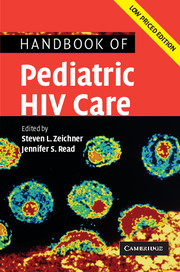Book contents
- Frontmatter
- Contents
- List of contributors
- List of abbreviations
- Foreword
- Preface
- Part I Scientific basis of pediatric HIV care
- Part II General issues in the care of pediatric HIV patients
- Part III Antiretroviral therapy
- Part IV Clinical manifestations of HIV infection in children
- 18 Cutaneous diseases
- 19 Neurologic problems
- 20 Ophthalmic problems
- 21 Oral health and dental problems
- 22 Otitis media and sinusitis
- 23 Cardiac problems
- 24 Pulmonary problems
- 25 Hematologic problems
- 26 Gastrointestinal disorders
- 27 Renal disease
- 28 Endocrine disorders
- 29 Neoplastic disease in pediatric HIV infection
- Part V Infectious problems in pediatric HIV disease
- Part VI Medical, social, and legal issues
- Appendix 1 Formulary of antiretroviral agents
- Appendix 2 National Institutes of Health sponsored clinical trials for pediatric HIV disease
- Appendix 3 Selected HIV-related internet resources
- Appendix 4 Selected legal resources for HIV-infected children
- Index
- References
29 - Neoplastic disease in pediatric HIV infection
Published online by Cambridge University Press: 23 December 2009
- Frontmatter
- Contents
- List of contributors
- List of abbreviations
- Foreword
- Preface
- Part I Scientific basis of pediatric HIV care
- Part II General issues in the care of pediatric HIV patients
- Part III Antiretroviral therapy
- Part IV Clinical manifestations of HIV infection in children
- 18 Cutaneous diseases
- 19 Neurologic problems
- 20 Ophthalmic problems
- 21 Oral health and dental problems
- 22 Otitis media and sinusitis
- 23 Cardiac problems
- 24 Pulmonary problems
- 25 Hematologic problems
- 26 Gastrointestinal disorders
- 27 Renal disease
- 28 Endocrine disorders
- 29 Neoplastic disease in pediatric HIV infection
- Part V Infectious problems in pediatric HIV disease
- Part VI Medical, social, and legal issues
- Appendix 1 Formulary of antiretroviral agents
- Appendix 2 National Institutes of Health sponsored clinical trials for pediatric HIV disease
- Appendix 3 Selected HIV-related internet resources
- Appendix 4 Selected legal resources for HIV-infected children
- Index
- References
Summary
Introduction
HIV-infected patients have an increased incidence of malignancies. Three malignancies constitute AIDS-defining diagnoses: Kaposi's sarcoma (KS), non-Hodgkin's lymphoma (NHL), and cervical cancer. There are increased risks for other cancers [1]. Approximately 40% of HIV-infected adults develop cancer [2]. The neoplastic disease risk in HIV-infected children exceeds that of adults, but because of low background incidence, cancers are uncommon in children living in the West. In certain parts of Africa, pediatric neoplastic disease may be more common [3].
Epidemiology of AIDS-related cancers
Kaposi's sarcoma (KS)
In the USA KS primarily affects men who have sex with other men (MSM), and their female partners [4]. In sub-Saharan Africa, it is common among heterosexuals and children [5]. Greater understanding of human herpesvirus 8 (HHV-8) also termed Kaposi's sarcoma-associated herpesvirus (KSHV), helps to explain KS geographic variation [6, 7]. KSHV is a necessary, though insufficient, component in KS etiology.
Approximately 50% of adults infected with HIV and KSHV develop KS within 10 years [8]. Those infected with KSHV before HIV infection have lower risks of KS than those already infected with HIV before KSHV [9]. KSHV may be transmitted sexually and from mother to infant [10]. In Africa, HIV-associated KS is seen in adults and children [11]. Males develop KS more frequently than females. KSHV seroprevalence varies substantially in different regions and in different populations, tracking KS epidemiology.
- Type
- Chapter
- Information
- Handbook of Pediatric HIV Care , pp. 637 - 650Publisher: Cambridge University PressPrint publication year: 2006



